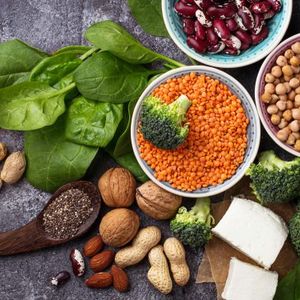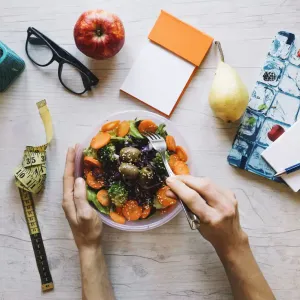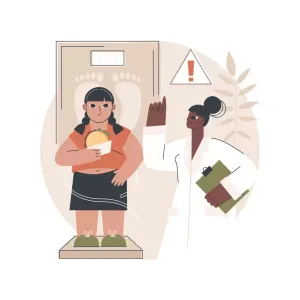

Our Review Process
Our articles undergo extensive medical review by board-certified practitioners to confirm that all factual inferences with respect to medical conditions, symptoms, treatments, and protocols are legitimate, canonical, and adhere to current guidelines and the latest discoveries. Read more.
Our Editorial Team
Shifa Fatima, MSc.
Author
Dr. Apoorva T, MHM.
MEDICAL ADVISOR
How to understand food labels?
Let’s be honest, we don’t end up eating fresh, home-cooked food as often as we’d like. Most times, our super busy schedules get in the way, and other times, we’re plain lazy (no shade, it happens to the best of us). But even as we seek alternatives such as ready-to-cook or packaged food, we want to be health conscious.
A lot of these foods often boast labels like ‘diet’, ‘organic’, or ‘zero trans fat’, which definitely sound healthy, but in many cases can be misleading. In fact, research shows that adding health claims to labels leads people to believe a product is healthier than the same product that does not contain health claims, thereby influencing consumers' purchasing decisions. How do you then make the right food choices? We’re here to clear up any confusion and help you make an informed decision when it comes to ready-to-eat foods.
Table of Contents
What is a Food Label?
For a person living with diabetes, food is one of the most important aspects that play a role in the ups and downs of sugar levels. Depending on the carb content, sugar content, etc in the food, the body’s blood sugars levels may go high steadily or rapidly. This is why being aware of the contents of the food is super important. This will help you understand how much insulin to take, by counting carbs, and also when would be the best time to take the dose that would result in a slow increase of the blood sugar which would be mitigated by the effect of the insulin dose.
This information can be obtained via the food labels. Food labelling provides useful information that will help you make an informed choice about what to eat and drink and how much. Packaged foods are almost always equipped with food labels to be able to give their customers the required information on the nutritional values and other contents.
Some of the information on the food labels would be:
- Insight into what the food is
- The details about the manufacturer
- Nutritional values
- List of Food Ingredients
- Weights and measures of the food items or products
- Date marking
- Country of origin
- Directions for storage and use
- Allergens or additives
- Health-related claims.
Some types of labels could be:
- Best-before date labels – This means that the food quality and food stored will remain good until that date. While the food may be safe to consume after the date has passed, it may lose some of its nutritional values and quality.
- Use-by date labels – These foods cannot be consumed after the date has been surpassed. They are not safe to be sold. This is most commonly found in meat, fish, dairy products, etc.

Understanding Important Food Labels
Food labels are a legal and necessary requirement for a food producer to add to their packaging to be able to give the consumers the choice to make an informed decision about their purchases. Not only to understand what the nutritional values and contents of the food items entail but also to be able to get an idea of how long the food will remain fresh and viable to eat. Especially for people with certain medical conditions like obesity, diabetes, heart diseases, allergies, etc, these values become important to know.
Label Lingo
First, let’s take a look if some of the common labels you see on pre-packaged foods are healthy as they appear?
Organic
What does it mean? : Products with the organic label must contain primary ingredients that are grown through organic farming methods. This means that they were grown without the use of synthetic chemicals like fertilizers and pesticides, antibiotics, and hormones, and without the use of GMOs (genetically modified organisms).
What to look for : Organic Certification. A true organic product will be certified by an agency such as Quality Assurance International (QAI), Agricultural and Processed Food Products Export Development Authority (APEDA), or India Organic. These agencies ensure that everything from the product itself to the soil it grows in goes through rigorous testing, so you can be certain you’re buying an authentic product.
Warning Signs : Products that are not certified by an official body are likely not organic. Keep in mind price point and seasonality as well, organic foods tend to be a little pricier but seasonal produce are grown in abundance, and are usually just as good for your wallet as they are for your body.
Is this healthy? : Yes! Buying organic means you’re introducing fewer synthetic chemicals like pesticides and fertilizers and antibiotics to your body. Know about is honey good for diabetes?.
No added sugar/No sugar
What does it mean? : Products with this label mean that no sugar has been added to sweeten the product while processing it.
What to look for : Read the ingredients. Choose products with no or less added sugar .There are hidden sugars named differently. Buy products having whole grains, which your body can naturally breakdown and convert into energy. Another option is to switch to unsweetened or naturally sweetened products.
Warning Signs : The presence of artificial or hidden sweeteners. Check the ingredients, if you see unfamiliar ingredients ending in -al, -ol, malt or -ose, it’s likely a sugar substitute. Some common examples are sorbitol, dextrose, maltitol and sucralose malt syrup. Corn syrup is another common sugar substitute, usually labeled high fructose corn syrup (HFCS), and is often used in breakfast cereals and commercial cookies and biscuits. Adding too many of these foods to your diet can cause increased weight gain inflammation in the body.
Is this healthy? : Not necessarily. It’s important to remember that sugars are needed by our body to make energy — the average adult should consume about 30 grams a day. However, most of our body’s required sugar intake comes from breaking down carbohydrates. Artificial sweeteners can be low on your caloric intake,but high consumption can disrupt your gut health. Sucralose and sulfonamides, for example, can cause allergic reactions and even aid many metabolic disorders. Also read about sugar free biscuits.
Natural Sugars
What does it mean?: The product uses natural sweeteners, such as honey, fruit sugars rather than processed white sugar.
What to look for: Ingredients such as figs and dates which are naturally high in sugar. A shorter shelf-life is another good hint that the product uses natural ingredients instead of processed ones or ones with preservatives.
Warning signs : Processing these sweeteners can change their chemical makeup. This reduces their nutritional value, and may even create imbalances in your body. Also be on the lookout for fruit syrups, nectars, and concentrates, which are ultra-processed and highly concentrated even if they sound natural.
Is it Healthy?: Not always. If the product contains ultra-processed foods or preservatives, it may not be a healthy option. Foods that contain high amounts ofsweeteners, like berry concentrates, can compromise sugar levels. Moderation is the key here. Replacing these with foods that contain figs, dates, and prunes, or even sweet nuts like coconuts and pecans in moderation can be a healthier option. Stevia leaves are another well-known natural sweetener, though they may have a bitter aftertaste.
Whole Grain
What does it mean? : The product either contains grains in its whole form or is made from flour that contains all parts of the grain seed or has added bran (outer layer of the grain). If the product uses all three parts of the grain, bran, germ and the endosperm, it is 100%whole grain.
What to look for : 100% whole grain label and high fiber content, added oat or wheat bran, no added sugar.
Warning Signs : Check the ingredients and nutrition label. A whole-grain product should be relatively high in fiber (more than 3 grams of fibre per 100 grams) and not include other processed ingredients like maida or other refined flours. More processed grains are lower in fibre.
Is it Healthy? : Yes! Fiber is very important for your gut health and digestion. On average, people require 35-40 grams a day, so high fiber foods should be incorporated into every meal. Keeping fruits and vegetables to half your plate is one way to ensure you get this fibre content, but whole-grain and whole pulses are great options as well. Just make sure that you’re not consuming a whole lot of added sugar in the bargain!
Real Ingredients
What does it mean? : The product uses real fruits and vegetables rather than concentrates or flavorings. However there’s no guarantee that the product contains a high percentage of real produce.
What to look for : A high fiber content. The higher the fiber the less processed the food product is.
Warning Signs : Even real ingredients lose their nutritional value if they’ve been processed for too long, so check the nutrition label carefully. If the product is low in fiber but high in sugars or calories, the product isn’t using real ingredients.
Is it Healthy? : It depends. Products that are less processed are definitely healthy, for example a date and nut bar , But some – like a 100% real fruit juice – can have concentrated forms of sugar and may have been clarified to take out the fibre. The healthier bet would be to replace these foods with actual fruits and vegetables, which have many more health benefits, and make quick and easy snacks too!
For example
If you compare an apple to apple juice made from ‘real ingredients’, the apple gives you the benefit of all the pulp and fiber found in the fruit, as well as healthy complex sugars. The act of biting can also help keep your teeth clean, and chewing the fruit means that your saliva can begin the digestive process from the mouth. This is a better choice for your digestive system and also means that you stay full and satiated for longer. The juice on the other hand is less filling, it may have added sugars that are addictive, and has almost double the calories of the apple per 100g with lesser nutritional value.
Zero Trans Fat
What does it mean? : The product contains less than 1% of non-saturated fat. This doesn’t necessarily mean there is no trans fat — a product containing 0.5% trans fat can also be labeled as a zero trans fat product.
What to look for : Check the nutrition label to make sure that the amount of fat per serving size is low.
Warning Signs : Hidden quantities of saturated fat and cholesterol. Products that contain dairy, for example, are naturally fatty and will have a highercholesterol value even if they’re labeled as zero trans fat. A vegetarian product can still be a low valued product if it has excess amount of hydrogenated oils(vegetable oils hardened artificially, such as vanaspati)
Is it Healthy? : Not necessarily. Zero trans fat doesn’t mean no fat at all. That means that it really depends on what kinds of fat you’re consuming and how much. Trans fat and hydrogenated vegetable oils can increase risk of cardiovascular diseases by increasing the bad cholesterol (the LDL) and decreasing (the HDL) the good cholesterol.
Diet
What does it mean? : Diet is a marketing term, used to indicate a product that is low fat and sugar-free, and thus ‘healthier’.
What to look for : Check the ingredients for processed flours, artificial sweeteners, and preservatives, and check the nutrition label for sodium content. The average adult is recommended to consume no more than 5 grams of sodium in a day.
Warning Signs : Processed ingredients like rice flour or refined white flour can reduce the nutritional value of diet snacks. Artificial sweeteners (found especially in diet sodas) can also be inflammatory for your body. High sodium, preservatives, and artificial colours and flavorings can all cancel out the ‘low fat’ benefit of these foods.
Is it Healthy? : Not as much as you think. We’ve already talked about the possible issues that come from processed ingredients and artificial sweeteners, but there’s a third pitfall of ‘diet’ foods. They’re often packed with high amounts of sodium, hidden sugars, and artificial flavors, which make them tastier, but also extremely addictive. And consuming these ingredients in large quantities can upset your body by causing bloating, water retention, gut damage.
Also read about benefits of dates for diabetes

What you can look out for while reading a label?
When you’re out shopping for groceries, there are a few things to keep in mind, whether you’re looking for ready-to-eat meals or just something to snack on.
- Always check Serving Sizes : The nutritional values given on the label apply to a certain amount(serving size) of the product. If you want to know how much you’re getting per packet(entire weight of the whole product, say 50g chips), or even per serving (25g per serving) , you’re probably going to have to do some math.
- Don’t let Percentages fool you : Some nutritional values may be written as percentages. If a cereal promises 10% of your recommended daily dosage of fiber, it’s offering you 3.5 grams, you’ll need to get the other 31.5 grams elsewhere.
- Do the right math : When you’re checking calorie count, remember to do the math to make sure you’re accounting for a whole serving. Check if the trade-off is worth it. Should you buy whole-grain digestive biscuits that give you only 2% of your required fiber but half your required sugar, or would another option be healthier?
- Always check the label for:
- Protein content
- Carbohydrates
- Fiber
- Type and quantity of fats
- Natural vs artificial sugars
- Sodium
- Micronutrients such as iron, vitamins, etc.
- Expiry date (shorter shelf-life means fewer preservatives)
Food Labels may contain also contain sugar information with different names; To avoid accidentally consuming too much sugar, look out for these most common sugar names in ingredient lists:
- Sugar Types: Beet Sugar, Brown Sugar, Butter Sugar, Cane Sugar, Powdered Sugar, Coconut Sugar, Date Sugar, Gold Sugar, Invert Sugar, Muscovado Sugar, Organic Raw Sugar, Raspadura Sugar, Evaporated Cane Sugar, and Powdered Sugar.
- Types of syrup: locust bean syrup, gold syrup, high fructose corn syrup, honey, agave syrup, malt syrup, maple syrup, oat syrup, rice bran syrup and rice syrup.
- Other Added Sugars: Barley malt, molasses, cane juice crystals, lactose, corn sweetener, crystalline fructose, dextran, malt powder, ethyl maltol, fructose, fruit juice concentrate, galactose, glucose, disaccharides, maltodextrin and maltose.
Bottom Line
When it comes to eating healthy, even with packaged foods, food literacy is the most important tool in a consumer’s arsenal. It may take a few months to develop the habit to read to read nutrition labels, food labels, but it’s worth the effort. Read labels and decide whether those are the ingredients you want on your plate. Do your best to pick foods that are as close to natural as you can get, and remember that you don’t have to sacrifice your health in the name of convenience. If you want to know more or need help, do reach out to a health coach.
FAQs
What are labels used for?
The labels that are applied on various food items are used to make the buyer informed about various aspects of the item that he is about to buy. These aspects must include things like ingredients used to manufacture the item, overview of the product, details of the manufacturer, nutritional values, quantity of ingredients, markings of important dates, and a few other informative things that are used to make the buyer aware of the product fully before he purchases it. It is important to know what you are going to intake as the contents of the item can directly have a good or bad impact on your health.
What should be on a label?
A label must contain certain important information like details of manufacture, product overview, nutrition values, ingredients used for manufacturing the item, the quantity of each ingredient used, markings of vital dates, the origin country of the item, detailed steps for using and storing the item, allergens and additives, and other health-related implications. A proper label would be the one that makes you knowledgeable about what impact the intake of that item will have on your body. Using this information, you can decide whether to include or exclude that item from your diet and purchasing list.
References
- https://eatrightindia.gov.in/how-to-read-label.jsp
Disclaimer
This website's content is provided only for educational reasons and is not meant to be a replacement for professional medical advice. Due to individual differences, the reader should contact their physician to decide whether the material is applicable to their case.







